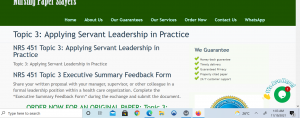Topic 3: Applying Servant Leadership in Practice
Topic 3: Applying Servant Leadership in Practice
Share your written proposal with your manager, supervisor, or other colleague in a formal leadership position within a health care organization. Complete the “Executive Summary Feedback Form” during the exchange and submit the document.
In this assignment, you will propose a quality improvement initiative from your place of employment that could easily be implemented if approved. Assume you are

NRS 451 Topic 3 Applying Servant Leadership in Practice
presenting this program to the board for approval of funding. Write an executive summary (750-1,000 words) to present to the board, from which the board will make its decision to fund your program or project. Include the following:
- The purpose of the quality improvement initiative.
- The target population or audience.
- The benefits of the quality improvement initiative.
- The inter-professional collaboration that would be required to implement the quality improvement initiative.
- The cost or budget justification.
- The basis upon which the quality improvement initiative will be evaluated.
Prepare this assignment according to the guidelines found in the APA Style Guide, located in the Student Success Center. An abstract is not required.
This assignment uses a rubric. Please review the rubric prior to beginning the assignment to become familiar with the expectations for successful completion.
You are required to submit this assignment to LopesWrite. Refer to the for assistance. Topic 3: Applying Servant Leadership in Practice
Describe the fundamental principles of Present two qualities of servant leadership and explain how they support interprofessional communication in providing patient care.
Describe the characteristics of performance-driven team. Describe the difference between intrinsic and extrinsic motivation and explain why it is important in understanding the types of motivation when it comes to team performance.
In order to accomplish daily goals in the nursing industry, nurses are constantly under pressure. Working together toward a common objective makes a group stronger than the sum of its parts (Dill, 2014). A high-level team can be a challenge for nurse leaders because of communication breakdowns, especially if the team members keep changing over time. With defined goals and a feeling of purpose, a performance-driven team can be maintained by its leaders. The team’s roles and responsibilities are clearly defined, and everyone is on the same page. In order for a team to be successful, there must be a sense of trust and mutual respect among its members. Leadership in a high-performance team must be shared and participatory in order to make the best decisions. A high-performance team has good working practices that allow all team members to be actively involved in the team’s work. The team appreciates the diversity of generation, culture, and thinking in order to form a strong team. The members are adaptable and flexible, which promotes good working relationships (Thomas, 2018). In order to motivate employees, both intrinsic and extrinsic motivation can be used. A person’s desire to engage in a particular activity is fueled by their own personal satisfaction, delight, or curiosity in the activity itself. If you’re interested in working with people, you might consider becoming a nurse.
References:
Dill, J. (2014). Nurses motivated by external rewards are more likely to survive on the job. The Conversation. Retrieved from: https://www.google.com/amp/s/theconversation.com
Thomas, J. S. (2018). Nursing Leadership and Management: Leading and Serving. Grand Canyon University. Retrieved from: https://www.gcumedia.com/digital-resources/grand-canyon-university/2018/nursing-leadership-and-management_leading-and-serving_1e.php
Re: Topic 3 DQ 2
To thrive in an expanding health care system, effective teams must be formed throughout the health care system. A performance-driven team in healthcare is the result of nurse leaders who engage their staff, provide opportunities for personal communication, demonstrate genuine investment in their staff’s well-being, and intrinsically motivate individuals to perform at their highest level.
Motivation is a need or drive that propels a person toward achieving a goal. It can be both intrinsic and extrinsic (Verywell Mind, 2019). Intrinsic motivation drives people to engage in a specific behavior because it is personally rewarding and is driven by internal rewards. The act of engaging in the behavior is its own reward. For example, by implementing a lifestyle change such as regular exercise, an individual will begin to feel better as a result of the exercise, which will keep him or her motivated to continue exercising. Extrinsic motivation entails engaging in a behavior or activity in order to earn a reward or avoid punishment. Using the same exercise example, a person may train for a marathon in order to receive a medal for participation. If this is the only motivator, the individual may find it difficult to maintain an exercise regimen after the marathon.
Nursing offers numerous extrinsic rewards, such as a salary, health care benefits, and social status. Under , long-term organizational change in healthcare is possible. Servant nurse leaders can collaborate with motivated interprofessional teams to achieve the best possible patient outcomes. Many factors influence a nurse’s motivation in the workplace. Baljoon et al. (2018) discovered that a nurse’s work motivation is frequently influenced by a variety of personal and organizational factors that are critical in influencing the level of nurses’ work motivation. By understanding these factors and channeling a nurses’ work effort to achieve the organization’s goals, nurse leadership within a servant leadership framework can help nurses stay intrinsically motivated. This effort motivates a high-performing team.
References
Baljoon, R. A., Banjar, H. E., Banakhar, M. A. (2018). Nurses’ work motivation and the factors affecting it: A scoping review. International Journal of Nursing & Clinical Practices 5(277) 1-10. Retrieved from https://doi.org/10.15344/2394-4978/2018/277
Verywell Mind (2019). Intrinisic Motivation [website]. Retrieved from
Do you need a similar assignment written for you from scratch? We have qualified writers to help you.
You can rest assured of an A+ quality paper that is plagiarism free. Order now for a FREE first Assignment!
Use Discount Code "FREE" for a 100% Discount!
NB: We do not resell papers. Upon ordering, we write an original paper exclusively for you.

